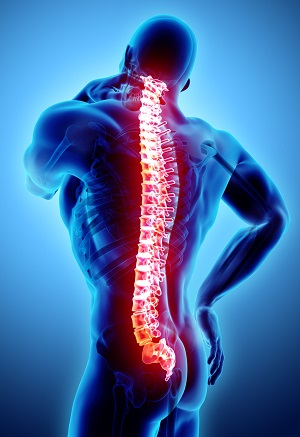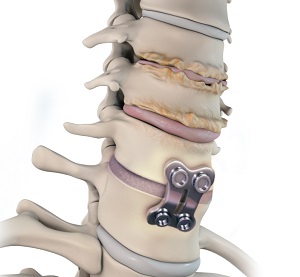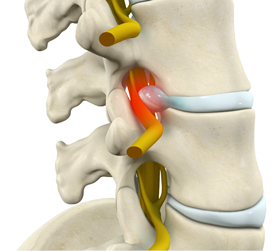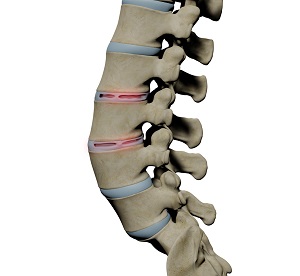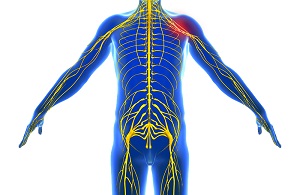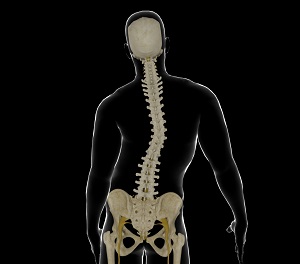- Scoliosis

Scoliosis is a condition characterized by the abnormal curvature of the spine that causes a deviation to one side.
Know More - Kyphosis

Kyphosis is a condition of abnormal curvature of the spine that causes rounding of the upper back or a hunchback.
Know More - Spinal Tumors

A spine tumor is the abnormal growth of uncontrolled tissues or cells in and around the spinal cord.
Know More - Disc Herniation

Disc herniation is a condition where the central nucleus pushes through the outer edge of the disc, causing a bulge that compresses the spinal nerves.
Know More - Spinal Stenosis

Spinal stenosis is a condition caused by the vertebral column constricting and exerting pressure on the spinal cord or neural foramen (a bony tunnel through which a nerve exits the spinal cord).
Know More - Spondylolisthesis

Spondylolisthesis is the displacement of the vertebral disc from the spinal column.
Know More - Spine Deformities

The spine has two gentle curves, when viewed from the side and appears to be straight when viewed from the front. When these curves are exaggerated, pronounced problems can occur such as back pain, breathing difficulties and fatigue.
Know More - Spinal Fractures

Vertebral compression fractures occur when the normal vertebral body of the spine is squeezed or compressed.
Know More - Spinal Disorders

The spine is made up of a column of small bones called vertebrae that surround and protect the spinal cord and nerves that branch out from the spinal cord.
Know More - Spondylolysis

Spondylolysis is a stress fracture in the vertebra that may progress into spondylolisthesis, a condition where the vertebra gets displaced from the spinal column.
Know More - Spondylodiscitis

Spondylodiscitis is an infection of the intervertebral discs (between the vertebrae) along with the vertebrae (one of many small bones forming the spine).
Know More - Spondyloarthropathies

Spondyloarthropathies are a group of chronic inflammatory diseases of the spine and joints. Spondyloarthropathies can occur at any age, however, they occur more often in young males.
Know More - Spine Arthritis

Spine arthritis is a condition characterized by the inflammation, degeneration, or wearing out of cartilage in the joints of the spine.
Know More - Facet Joint Arthritis

Facet joints, also called zygapophyseal joints, are synovial joints located at the back of your spine, connecting the vertebrae together.
Know More - Sciatica

The sciatic nerve is the longest nerve in your body. It begins in the lower back and extends through the buttocks down the back of each leg to the thighs and feet.
Know More - Degenerative Disc Disease

Degenerative disc disease (DDD) refers to the gradual deterioration of the intervertebral discs between the vertebrae. DDD is a misnomer as it is not actually a disease but a condition that affects the strength, resilience and structural integrity of the intervertebral discs due to advancing age, trauma, injury, repetitive movement, improper posture or poor body mechanics.
Know More - Spine Trauma

Spine trauma is defined as an injury or damage to any region of the spine.
Know More - Sacroiliac Joint Dysfunction

Sacroiliac joint dysfunction or sacroiliac joint pain is one of the common causes of low back pain.
Know More - Benign Spinal Tumors

The spinal cord is a long bundle of nerves that extends from the brain along the length of the spinal column.
Know More - Arm Pain of Spinal Origin

Arm pain of spinal origin can be described as discomfort or pain felt anywhere in the arm including the wrist, elbow, or shoulder as a result of a pinched nerve (nerve compression) or irritated nerve in the spinal cord.
Know More - Skeletal Dysplasia

Skeletal dysplasia, also called osteochondrodysplasia, is the term used for growth or developmental disorders of the bone and cartilage.
Know More - Diffuse Idiopathic Skeletal Hyperostosis (DISH)

Diffuse idiopathic skeletal hyperostosis (DISH) is a condition that commonly affects the spine.
Know More - Spinal Instability

Spinal instability refers to the condition of failure of the spinal column to maintain its normal structure.
Know More - Vertebral Compression Fractures

Back pain is an indication of stress fractures known as vertebral compression fractures.
Know More - Traumatic Spinal Cord Injury

A traumatic spinal cord injury is an injury from sudden physical trauma that results in a fracture, dislocation, or compression of one or more spinal vertebrae and the bruising or tearing of any part of the spinal cord or cauda equina, the bundle of nerve roots at the lower end of the spinal canal.
Know More - Spine Injuries in Athletes

Spine injuries in athletes are defined as damage sustained by the spine as a result of physical trauma or overuse in people who are actively involved in sports.
Know More - Adjacent Segment Disc Disease

Spinal fusion surgery involves the fusion of two or more vertebral bones and is a standard of care for spinal deformities and conditions such as radiculopathy, myelopathy, and spondylolisthesis.
Know More - Spinal Infection

A spinal infection is described as an infection of the spine. It can occur in various locations of the spine i.e., intervertebral disc space, vertebral column, spinal canal, and nearby soft tissues.
Know More - Adult Degenerative Scoliosis

Adult degenerative scoliosis is characterized by side to side or lateral bending of the spine in adults. Degenerative scoliosis can involve either the mid-back and/or lower back region of the spine.
Know More - Adult Kyphosis-Types & Causes

Kyphosis may gradually develop in certain paralytic disorders such as poliomyelitis, spinal muscle atrophy, and cerebral palsy.
Know More - Radiculopathy

Radiculopathy is a condition where a nerve root in the spine is compressed, producing pain or weakness across the whole length of the nerve. It is sometimes referred to as a pinched nerve or sciatica. It occurs most commonly, but is not limited, to the lower back and neck.
Know More - Osteoporosis of the Spine

Osteoporosis is a bone disease characterized by a decrease in bone mass and density resulting in brittle, fragile bones that are more susceptible to fractures.
Know More - Degenerative Spinal Conditions

A degenerative condition is a continuous deterioration of a tissue or an organ in your body over time.
Know More - Disc Changes

The cartilaginous disc is made up of an outer fibrous layer called the annulus fibrosus, which surrounds an inner gelatinous core called the nucleus pulposus.
Know More - Ankylosing Spondylitis

Sacroiliac joints are present in the lower back where the sacrum part of the vertebrae joins the iliac bones.
Know More - Spina Bifida

Spina bifida is a congenital condition (birth defect) in which there is abnormal development of the back bones, spinal cord, surrounding nerves, and the fluid-filled sac that surrounds the spinal cord.
Know More - Poor Balance

Poor balance can be defined as a sense of unsteadiness on your feet due to dizzy spells or lightheadedness, fainting, blackouts, or loss of consciousness.
Know More - Kyphosis in Children

Kyphosis is an abnormal curvature of the spine that causes rounding of the upper back or a “hunchback”.
Know More - Metastatic Tumors

A tumor (lump or mass) in your spine is an abnormal growth of tissue within or around your spinal column or spinal cord.
Know More - Pathological Fractures of the Spine

Pathological fractures are broken bones in an area already weakened by another disease, not by an injury. Some underlying diseases can weaken the spinal bones making them brittle and eventually causing a fracture or break in the bone.
Know More - Peripheral Nerve Compression

The human body has 2 nervous systems, the central nervous system that includes the brain and spinal cord, and the peripheral nervous system that includes a network of nerves that lie outside the brain and spinal cord.
Know More - Idiopathic Scoliosis

Scoliosis is a medical condition characterized by an abnormal lateral curvature of the spine, either to the left or to the right.
Know More












